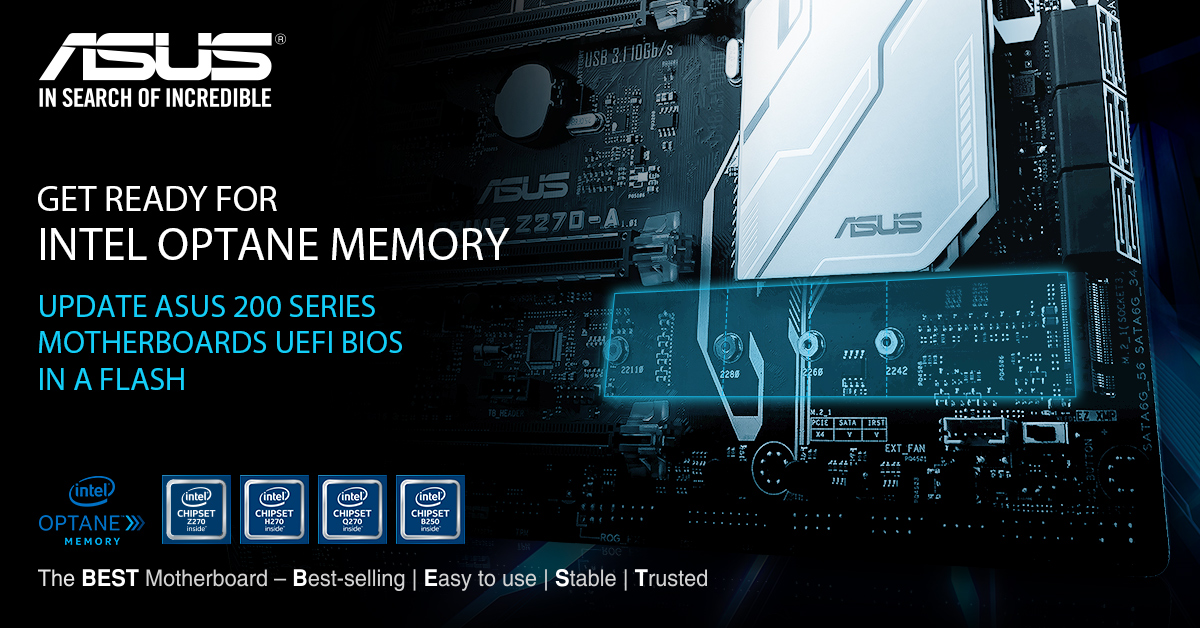Earlier this month, Intel officially started rolling out products based on its new 3D XPoint technology, which aims to be the future of SSDs thanks to its much faster speeds when compared to NAND. This all started out with a very expensive 375GB SSD, which would only really be useful and affordable to data centres. However, yesterday, Intel expanded its offerings with Optane Memory, a cache drive of sorts intended to bring serious performance boosts to system storage.
Optane Memory is essentially an M.2 SSD cache drive, it comes in 16GB and 32GB sizes and is there to speed up performance of traditional HDDs. This means frequently used application load times, PC boot times and gaming load times would all receive a noticeable bump in theory.
However, only some motherboards can support it and today, ASUS announced that it would be pushing out a new UEFI BIOS update to compatible ASUS 200-series motherboards. An exact list of supported motherboards will be coming soon but if you own a higher-end ASUS board, chances are you'll be getting the Optane Memory update.
KitGuru Says: Intel's new Optane Memory looks very interesting indeed. It could end up being a good alternative to buying a large SSD for use cases like gaming. However, with support limited to 200-series motherboards, adoption may end up being slow. What do you guys think of Intel's new Optane Memory drives? Do you think they will end up being useful?
 KitGuru KitGuru.net – Tech News | Hardware News | Hardware Reviews | IOS | Mobile | Gaming | Graphics Cards
KitGuru KitGuru.net – Tech News | Hardware News | Hardware Reviews | IOS | Mobile | Gaming | Graphics Cards




https://uploads.disquscdn.com/images/a876b3034e19a4c3eef2f0580868d1cdb58fa37f49323808167440166ba0d1f0.jpg
I want to know if on non-200 series boards (i.e Z170 boards), the drive still appears as a standard drive when connected. Would be interesting to stick just windows on it and keep everything else to a seperate ssd.
So far this Xpoint/optane stuff seems like a load of BS. The “benefit” slides have been lowering and lowering every press release and very little in the way of hard data.
And then there’s this:
http://semiaccurate.com/2017/03/27/intel-crosses-unacceptable-ethical-line/
Owner of Yahoo and Google!, is telling consumers to get started “Work at home” practice, that People have been doing for about 12 months now. This year alone, I made as much as $36k until now with no more than my laptop or computer and some spare time, although i have a regular nine to 5 job. Even people newbie in this, can make $50/per h successfully and the profit might be even higher over time… This is how i started >> http://kxk.me/?WW7Ig
This is the question so many of us want an answer to. I have no use case for it as it is being marketed now, as a cache drive. I have 200TB of LSI RAID6 data, a few RAID0 SATA arrays and NVMe arrays, at 3GB/s. But I could really use something like this in 16GB or 32GB size, for a stand-alone SSD drive for my VisualStudio projects which read and write many small files that don’t ever benefit from 3GB/s sequential access of my Samsung 950 RAID 0 arrays.
I have also read that these devices will work on Z170 systems but perhaps just not as “approved” systems – they are going after the Generation 7 Kaby Lake to start with.
I don’t see it booting Windows a much faster (something I never care about) than a Samsung SATA 850 and general OS operations shouldn’t be much faster, but we will have to wait an see. I haven’t booted of a spinning drive in 7 or 8 years.